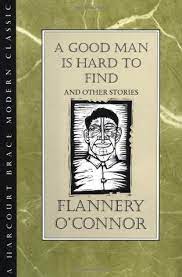
A Good Man Is Hard to Find and Other Stories
By Flannery O’Connor
252 pages
First published in 1955 by Harcourt Brace Jovanovich
A Good Man Is Hard to Find is a collection of short stories written by Flannery O’Connor. It was the Mules’ choice for December.
Flannery O’Connor is a name I know well. She is often referred to in essays about American literature. Mostly in essays written about other authors. I knew her to be an important writer in some way, but I didn’t know what way. In fact, I knew so little about her, I spent years thinking she was a he. (Can Flannery be a man’s name?)
The title of the collection is also the title of one of the stories within. It is, I read somewhere, one of the most anthologized in American fiction. And with good reason.
These are marvelous, engaging, and powerful stories – the work of a master writer. In reading them, I found myself comparing passages to the work of some of my favorite writers, including Jane Austen, Mark Twain, and Cormac McCarthy. But they’re hard to peg. Are they Literary Fiction? Black Comedy? Satire? Christian Morality Tales? Southern Gothic?
In discussing the book, Mules members agreed that all of these elements are there, though the collection can’t be fairly described using only one of those terms. They are better than that.
What we could not agree on was more fundamental: What was O’Connor’s view of the world when she wrote these stories? What was her view of humanity?
A few days later, one of the Mules sent out this email that gave us all more to think about:
“Smart people seem to think this month’s book by Flannery O’Connor is one of the best books ever written. I just finished the book, and I guess I’m just not that smart. So, in an attempt to figure out more about what made O’Conner tick and maybe learn why so many others think it’s such a great book, I decided to dig a little deeper into her background. There’s an incredible amount written about her. Here are just two articles that might shed some light on the possible ‘inspiration’ for her stories.”
Click here and here to read them.
What I Liked About It
* The intimacy of the stories
* The seeming authenticity of the dialog
* The crisply evocative descriptions of the scenery
* The literary sophistication of the syntax and diction
* The frailty and insufficiency of the primary characters
* The gentle satire that runs beneath almost everything
* The insight into the frailty of human nature
* The insight into the power of social culture
* The immensely impressive crafting of every element of fiction and style
What Was Irksome
O’Connor makes abundant use of the N-word. I am not one to object to the use of any word in literature. And I never felt that the N-word was used gratuitously in these stories. Still, I found myself psychologically wincing every time I came across it, which seemed like every 5 or 6 pages. I never felt this way when reading Tom Sawyer or Huck Finn 40 years ago or when watching Quentin Tarantino movies 20 years ago. But I had it while reading these stories that were published more than 65 years ago. This is obviously not a criticism of Flannery O’Connor. If anything, it’s a criticism of our culture.
Interesting Facts
* The title refers to an old blues song, written by Eddie Green (an African-American songwriter) in 1917 and recorded by Bessie Smith in 1927.
* A film adaptation of “A Good Man Is Hard to Find,” entitled Black Hearts Bleed Red, was made in 1992. It’s available on Amazon Prime video.

